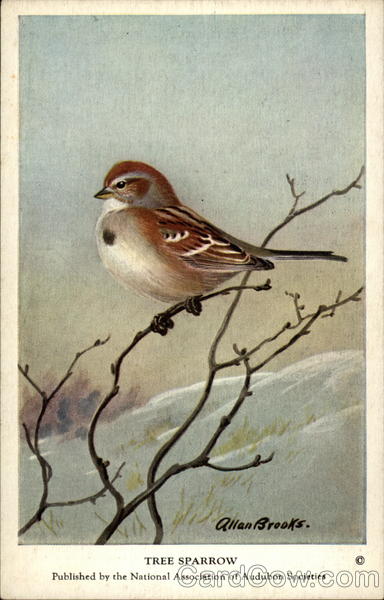Front:
allan Brooks.
TREE SPARROW
Published by the National Association of Audubon Societies
Back:
No. 37 Tree Sparrow
Length 644 inches
This interesting member of the Sparrow fam-
ily may readily be distinguished from its relatives
by its reddish crown and the solitary blackish-
brown spot in the center of its breast.
In mid-autumn it appears in our Northern
States, often with Juncos, and, as winter comes on
apace, it flocks in scattered companies over the
snow-clad fields. Like the Junco, the Tree Spar-
row frequents the thicket - bordered edges of
woodlands, old fence-rows grown up with vines
and briars, and especially weedy field. It also
comes to our gardens and often shares the feed-
ing-shelf with Chickadees Nutkatches and
As a destroyer of noxious seeds the Tree Spar-
row probably has no equal. Prof Beale, of the
Biological Survey, estimated that this little winter
sojourner consumes over 800 tons of weed-seeds
each season in the State of towe alone. If this be
true of Iowa, what enormone quantities must be
destroyed throughout its entire winter range!
The nest is usually on the ground, but some-
times in low bushes. There are four or five eggs,
pale greenish-blue, speckled with brown.
Classification: Order Passeres. Family Fringillide.
Scientific Name: Spizella monticola.
Range: Throughout North America, east of the plains;
breeding in Labrador and in the region of Hudson Bay.
It winters in the northern half of the United States.
No. 37 from set of 50 Winter Birds of the Northeastern United
States. Published by the National Association of Audubon So-
cieties, 1974 Broadway, New York City. Price per set, in a box,
$1.00 post paid.



